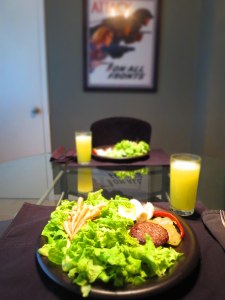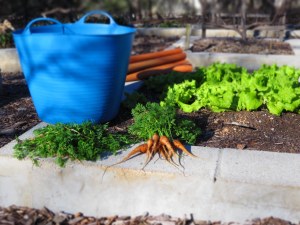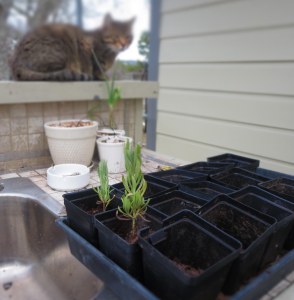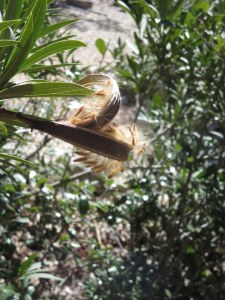Spooky Action Ranch Report: Week Five 2015
Garden to Table
As the winter crops are coming into their own, the fresh meals on the ranch have been ever increasing. Beet greens, spinach, lettuce and carrots are regularly making it onto the plate. This week we thinned our carrot beds, and the tiny carrots that came from this thinning constituted a nice little harvest, providing added flavor to several salads and snacks for the week. Additionally, we have been cutting fresh leaves from our Simpson Black Seeded Lettuce for daily salads, and the beet greens have provided a couple of tangy side dishes.
The carrot harvest had me thinking, though, about the whole concept of ‘baby carrots’ as we find it in our traditional super markets. The bags of little carrots you can buy at the market are not, of course, actually filled with baby carrots (and to be fair they do call themselves baby-cut carrots, but many people are not aware of the difference.) Baby carrots, just as you would imagine, are very small young carrots. They are tender and delicious, and usually served rinsed, whole, and preferably fresh from the garden. That is predominately what we ate this week. Baby-cut carrots are a different beast altogether, and its worth knowing how they are made so you can decide if they are the right choice for you and your family.
Baby-cut carrots go through an automated processing which whittles full sized carrots into the ubiquitous cocktail carrot shape. Since these mass processed carrots are a potential disease vector, the carrots are usually washed in a chlorine and water mix to kill potential pathogens, rinsed again, and then packaged for your convenience. That really is what you are buying when you pick up that bag of baby-cut carrot, convenience (and maybe a little bit of aesthetics too, but not my aesthetical preference).

How is this for ‘garden to plate’? Fresh salad from the garden, note the true baby carrots, venison and pickles from the ranch cupboards, and local pasture raised eggs.
I think avoiding both the potential disease vector and the harmful chemicals used to alleviate that concern are worth the extra work of cleaning and preparing carrots on my own. It is fairly quick and easy to peel and chop carrots for salad and snacks, plus all those scraps can be put in the compost to feed my local soil. I also think the work of preparing fresh food in the kitchen provides the benefits of a closer relationship with the food I eat, and since I am what I eat, as the saying goes, I like to know what my choices are making of me!
So next time you need carrots for dipping, stop at your local farmers market and pick up a bundle of fresh baby carrots, or take a little extra time and chop up your own carrot slices, you will see more health benefits from it, physically and spiritually.
Garden Cloning
This week we also transplanted our first cuttings from their initial rooting tray into individual pots for their next stage of growth. A couple of months ago, I took cuttings from several of our favorite landscaping plants. These plants grow well in our climate without too much attention, even in drought, and are not eaten by deer. We would like to propagate them through out the property. The four plant types that made the cut for this first trial were lavender, rosemary (two different varieties), and Texas sage.
It is possible to take non-woody cuttings from each of these plants and with the proper attention, get the cutting to sprout roots and form a new plant, really sort of a clone plant. The cutting I took several weeks ago have been living in our cold frames, enjoying higher temperatures and humidity. They seem to have rooted out pretty well, at about 90%, and I have now transplanted them into three inch pots to fill in a little more before they go into the earth. That will hopefully happen in a month or two.
I am very happy that the whole process is going well, since this gives me a lot of hope that the shaping of the overall ranch landscape can drive ahead with the clones of our favorite plants leading the way!
Oh, Leander
Actually, I mean Oleander. This beautiful and poisonous plant has gone to seed this past week. You may be familiar with the oleander flower. These large five petaled flowers, which produce a delightful aroma, close up into long hard seed pods which eventually dry up and burst open to release a plethora of fluffy seeds to scatter on the wind. The seed pods on our oleanders burst open this week, and one of our priorities is to walk these pods around the property, hoping to encourage a few volunteers out and about on the ranch. I’ll let you know if I spot any of our oleander’s descendents in the years to come.



